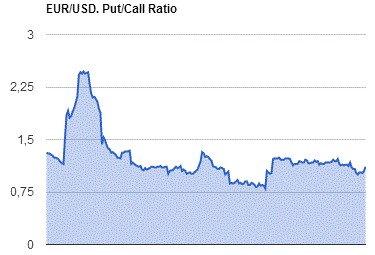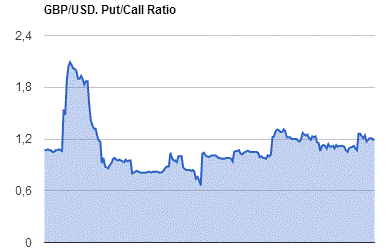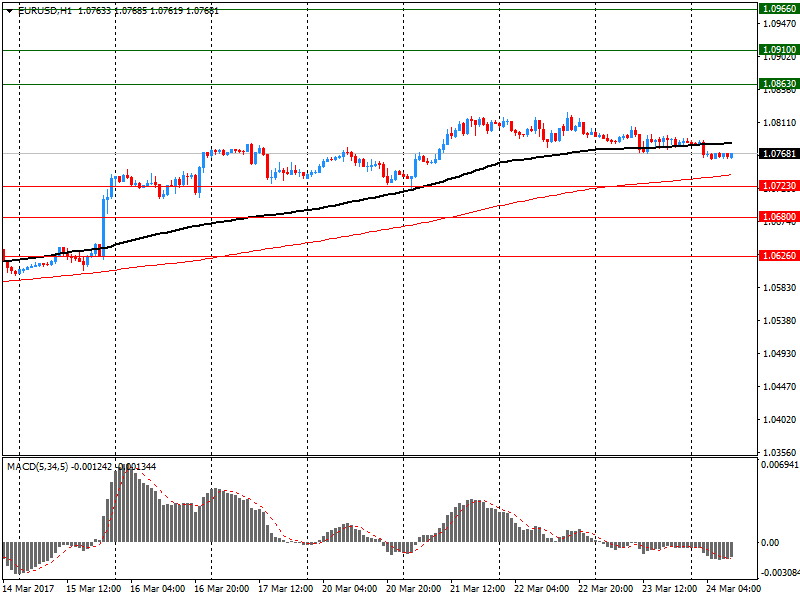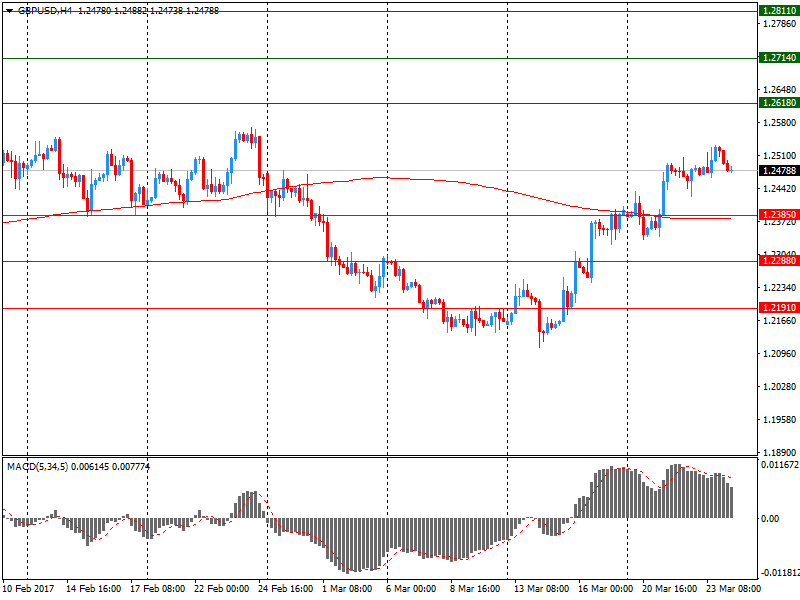Market news
-
15:16
Trump says Charter Communications has committed to investing $25 billion in U.S and hire 20,000 workers over four years
-
14:36
Fed's Dudley: may have inflation problem if you push unemployment much lower
-
Economy at pretty good place right now
-
Pretty close to employment, inflation objectives
-
U.S trade, immigration policies could hit international tourism to New York city
-
-
14:10
US services sector expanded slower than expected in March
The seasonally adjusted Markit Flash U.S. Composite PMI Output Index registered 53.2 in March, to remain above the 50.0 no-change value for the thirteenth consecutive month. However, the latest reading was down from 54.1 in February and signalled the slowest expansion of private sector output since September 2016. Softer business activity growth was driven by a loss of momentum in the service economy ('flash' index at 52.9, down from 53.8 in February).
Manufacturing production also expanded at a weaker pace in March ('flash' output index: 54.4, down from 55.6). March data also revealed a slowdown in staff hiring by private sector companies. The latest rise in payroll numbers was only marginal and the weakest for six months. The composite index is based on original survey data from the Markit U.S. Services PMI and the Markit U.S. Manufacturing PMI.
-
13:46
U.S.: Services PMI, March 52.9 (forecast 54.2)
-
13:45
U.S.: Manufacturing PMI, March 53.4 (forecast 54.8)
-
13:43
Bullard says Fed should be allowing balance sheet to shrink now
-
Inflation has essentially returned to 2 pct, expected to remain there
-
Unwise to forecast growth pickup in 2017
-
Labor market improvements have been slowing
-
Relatively low policy rate likely to remain appropriate
-
Fed can wait to see how fiscal policy evolves
-
-
13:25
Option expiries for today's 10:00 ET NY cut
EURUSD: 1.0650 (EUR 620m) 1.0740 (735m) 1.0750 (260m) 1.0785 (575m) 1.0800 (540m) 1.0850-55 (500m)
USDJPY: 110.00 (USD 1.6bln) 111.75 (910m) 111.90 (330m) 112.00 (1.5bln) 112.50 (365m) 112.90-113.00 (720m)
GBPUSD: 1.2370 (GBP 230m)
AUDUSD: 0.7525 (560m) 0.7675 (235m)
USDCAD 1.3200 (USD 400m) 1.3285 (400m) 133.00 (525m) 1.3340-50 (895m) 1.3400 (205m) 1.3430 (515m) 1.3490 (330m)
NZDUSD 0.6825 (NZD 590m) 0.7000 (225m) 0.7100 (250m)
EURJPY 121.00 (415m)
-
12:59
Orders
EUR/USD
Offers: 1.0820 1.0830 1.0850 1.0880 1.0900
Bids: 1.0780 1.0765 1.0750 1.0730 1.0700 1.0680 1.0650
GBP/USD
Offers: 1.2500 1.2530 1.2550-55 1.2580 1.2600 1.2630 1.2650
Bids: 1.2465 1.2450 1.2425-30 1.2400 1.2380 1.2360 1.2335-40 1.2320 1.2300
EUR/JPY
Offers: 120.30 120.50 120.85 121.00 121.50
Bids: 119.80 119.50 119.30 119.00 118.80 118.65 118.50
EUR/GBP
Offers: 0.8650-55 0.8685 0.8700 0.8725-30 0.8750 0.8780-85 0.8800
Bids: 0.8620 0.8600 0.8580-85 0.8550 0.8530 0.8500
USD/JPY
Offers: 111.50-55 111.65 111.80 112.00 112.25 112.50 112.80 113.00
Bids: 111.00 110.85 110.65 110.50 110.35 110.20 110.00
AUD/USD
Offers:0.7650 0.7665 0.7680-85 0.7700 0.7720 0.7735 0.7750
Bids: 0.7600 0.7580 0.7565 0.7550 0.7500
-
12:48
Canadian CPI inflation in line with expectations in February
The Consumer Price Index (CPI) rose 2.0% on a year-over-year basis in February, following a 2.1% gain in January.
Excluding gasoline, the CPI was up 1.3% year over year in February, following a 1.5% increase in January.
Prices were up in seven of the eight major components in the 12 months to February, with the transportation and shelter indexes contributing the most to the year-over-year rise in the CPI. The food index decreased for a fifth consecutive month.
Consumer prices increase in seven of the eight major components:
Transportation costs rose 6.6% over the 12-month period ending in February, after increasing 6.3% in January; this acceleration occurred despite a 0.8% monthly decline in February. On a year-over-year basis, consumers paid 23.1% more for gasoline and the purchase of passenger vehicles index was up 3.6%.
-
12:46
US orders for manufactured durable goods in February increased $3.9 billion or 1.7 percent
New orders for manufactured durable goods in February increased $3.9 billion or 1.7 percent to $235.4 billion, the U.S. Census Bureau announced today. This increase, up two consecutive months, followed a 2.3 percent January increase. Excluding transportation, new orders increased 0.4 percent. Excluding defense, new orders increased 2.1 percent. Transportation equipment, also up two consecutive months, led the increase, $3.3 billion or 4.3 percent to $80.4 billion.
Shipments of manufactured durable goods in February, up three of the last four months, increased $0.6 billion or 0.3 percent to $239.2 billion. This followed a 0.1 percent January decrease. Machinery, also up three of the last four months, led the increase, $0.3 billion or 0.9 percent to $31.1 billion.
-
12:30
Canada: Bank of Canada Consumer Price Index Core, y/y, February 1.7%
-
12:30
U.S.: Durable goods orders ex defense, February 2.1%
-
12:30
U.S.: Durable Goods Orders , February 1.7% (forecast 1.2%)
-
12:30
Canada: Consumer price index, y/y, February 2.0% (forecast 2.1%)
-
12:30
Canada: Consumer Price Index m / m, February 0.2% (forecast 0.2%)
-
12:30
U.S.: Durable Goods Orders ex Transportation , February 0.4% (forecast 0.5%)
-
11:38
German foreign ministry spokesman says foreign Min Gabriel had the impression in Greece that we are not far off reaching an agreement on the current reform review
-
11:10
Russian Central Bank lowers key rate to 9.75% from 10% expected
-
11:07
Russian economy minister says 4 pct inflation level will be reached no later than July
-
This should speed cutting of key rate
-
Steps to establish stable and predictable economic environment to anchor inflationary expectations
-
Obvious that Central Bank next steps to be linked to mid-term inflationary expectations
-
-
10:22
EU's Dombrovskis says modest recovery ongoing in Italy, GDP seen at +1% in 2017
-
09:47
UK mortgage approvals declined in February
The BBA's latest high street banking data shows that household borrowing of £13.4 billion in February was 4.6% higher than in the same month last year.
The BBA's latest high street banking data show that consumer credit is growing at an annual rate of 6.6%.
Gross mortgage borrowing of £13.4 billion in February was 4.6% higher than in the same month last year. After allowing for repayments, February's net mortgage borrowing was 2.5% higher than in February 2016.
Business borrowing continues to be subdued growing by 0.9% annually.
-
09:30
United Kingdom: BBA Mortgage Approvals, February 42.6 (forecast 44.9)
-
09:13
Eurozone economic growth gathered further momentum in March
Eurozone economic growth gathered further momentum in March, according to PMI survey data, reaching a near six-year high. The survey also saw the best employment growth for almost a decade as both manufacturing and service sector firms responded to surging order books. Business optimism meanwhile hit a new peak, but price pressures also intensified to a near six-year high.
The Markit Eurozone PMI rose to 56.7 in March, according to the preliminary 'flash' estimate (based on approximately 85% of final replies). Up from 56.0 in February, the latest reading was the highest since April 2011. The first quarter average of 55.7 is the highest since the first quarter of 2011.
-
09:00
Eurozone: Manufacturing PMI, March 56.2 (forecast 55.3)
-
09:00
Eurozone: Services PMI, March 56.5 (forecast 55.3)
-
08:44
Germany posted the fastest rate of private sector output growth in nearly six years - Markit
Germany posted the fastest rate of private sector output growth in nearly six years at the end of the first quarter of 2017. The March PMI survey data also signalled a near-record rate of employment growth and the strongest cost pressures for nearly six years.
The Markit Flash Germany Composite Output Index rose for the second month running from 56.1 in February to 57.0, the highest since May 2011 and signalling marked economic growth in the eurozone's largest economy. The current sequence of continuous expansion now stretches to 47 months.
-
08:30
Germany: Services PMI, March 55.6 (forecast 54.6)
-
08:30
Germany: Manufacturing PMI, March 58.3 (forecast 56.5)
-
08:07
March’s flash France PMI data highlighted a ninth consecutive month of private sector growth
The Markit Flash France Composite Output Index, based on around 85% of normal monthly survey replies, registered 57.6, compared to February's reading of 55.9.
The latest figure pointed to the sharpest rate of growth since May 2011. Service providers continued to raise their activity levels during March, thereby extending the latest sequence of growth to nine months. Moreover, the rate of expansion accelerated to a 70-month peak. Manufacturing output also continued to increase at a solid pace, albeit to a slightly weaker extent than in February.
-
08:00
France: Manufacturing PMI, March 53.4 (forecast 52.4)
-
08:00
France: Services PMI, March 58.5 (forecast 56.1)
-
07:46
France: GDP, Y/Y, Quarter IV 1.1% (forecast 1.1%)
-
07:45
France: GDP, q/q, Quarter IV 0.4% (forecast 0.4%)
-
07:30
Options levels on friday, March 24, 2017
EUR/USD
Resistance levels (open interest**, contracts)
$1.0966 (2334)
$1.0910 (990)
$1.0863 (47)
Price at time of writing this review: $1.0768
Support levels (open interest**, contracts):
$1.0723 (686)
$1.0680 (399)
$1.0626 (652)
Comments:
- Overall open interest on the CALL options with the expiration date June, 9 is 42148 contracts, with the maximum number of contracts with strike price $1,1450 (3934);
- Overall open interest on the PUT options with the expiration date June, 9 is 46160 contracts, with the maximum number of contracts with strike price $1,0350 (4017);
- The ratio of PUT/CALL was 1.10 versus 1.07 from the previous trading day according to data from March, 23

GBP/USD
Resistance levels (open interest**, contracts)
$1.2811 (1168)
$1.2714 (826)
$1.2618 (324)
Price at time of writing this review: $1.2478
Support levels (open interest**, contracts):
$1.2385 (574)
$1.2288 (251)
$1.2191 (478)
Comments:
- Overall open interest on the CALL options with the expiration date June, 9 is 15197 contracts, with the maximum number of contracts with strike price $1,3000 (1215);
- Overall open interest on the PUT options with the expiration date June, 9 is 17337 contracts, with the maximum number of contracts with strike price $1,1500 (3088);
- The ratio of PUT/CALL was 1.14 versus 1.14 from the previous trading day according to data from March, 23

* - The Chicago Mercantile Exchange bulletin (CME) is used for the calculation.
** - Open interest takes into account the total number of option contracts that are open at the moment.
-
07:03
The first round of the 2017 French presidential election will be held on 23 April. Should no candidate win a majority, a run-off election between the top two candidates will be held on 7 May 2017
-
07:01
Bank of America Merrill says EUR/USD will fall to 0.90 in days if Le Pen wins
Bank of America Merrill Lynch Research argues that there are highly asymmetric EUR implications into the French elections.
In that regard, BofAML believes the FX market is not pricing substantial risks for the elections in France.
In the most likely scenario in which Le Pen loses the second round, BofAML expects EUR/USD to strengthen towards 1.10.
"However, we see substantial EUR downside if Le Pen wins, believing that EUR/USD could weaken all the way to 0.90 within days," BofAML argues.
Source: Bank of America Merrill Lynch Rates and Currencies Research, efxnews.
-
06:58
US to vote on healthcare bill on Friday afternoon - AP
-
06:56
Flash Japan Manufacturing PMI slips to 3-month low - Markit
-
Flash Japan Manufacturing PMI slips to 3-month low of 52.6 in March (53.3 in February).
-
Flash Manufacturing Output Index at 53.4 (54.1 in February). Growth eases but remains marked.
-
Business confidence softens to four-month low.
Commenting on the Japanese Manufacturing PMI survey data, Paul Smith, Senior Economist at IHS Markit, which compiles the survey, said: "Although signalling a slower rate of expansion during March, the latest PMI data again point to a Japanese manufacturing economy expanding at a decent clip. Indeed, the data are consistent with manufacturing output expanding at an underlying trend rate of just below 2.0%. "New order books remain in solid growth territory, with gains seemingly supported by the weaker yen. However, this comes at the cost of ongoing marked rises in purchase costs: input price inflation remained close to a two-year high in March."
-
-
06:52
ECB's Praet: Euro Area doing better, return to Lira won't solve Italy's problems @LiveSquawk
-
05:04
Japan: Coincident Index, January 115.1
-
05:03
Japan: Leading Economic Index , January 104.9 (forecast 105.5)
-
00:30
Japan: Manufacturing PMI, March 52.6 (forecast 53.5)
-

